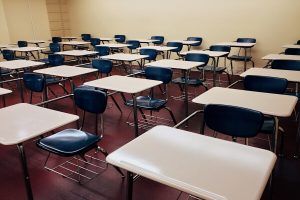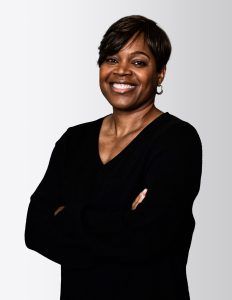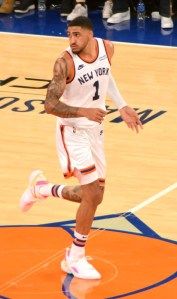Immigrant students may face hardships in FY24 budget

The constant influx of migrant families, and subsequent increased student enrollment, alongside the disparity in funding in public school programs in Mayor Eric Adams’s Fiscal Year 2024 budget, has raised concerns from Advocates for Children of New York (AFC), an organization devoted to safeguarding access to education for children.
The AFC recently issued a brief for the public with three distinct demands directed at Adams’s new FY2024 budget: first, aiding the large influx of immigrants enrolled in school since last year: second, extending funding to Promise NYC, a government-subsidized childcare and early education program for low-income families, primarily for undocumented children who might be ruled out from traditional schooling; and third, creating more services to support English Language Learners (ELL) programs at transfer schools.
Relative to immigrant families, the AFC reported that the city’s public school system enrolled more than 18,000 new students in temporary housing. The organization determined that immigrant student services are increasingly essential, due to the population of high school-age students increasing by 76.5 percent in March 2023 compared to March 2022.
The brief also reported that nearly 42 percent of students in New York City public schools live in primarily non-English–speaking households. Paired with U.S. Census information that finds thousands of students whose parents do not speak English fluently, many of the same families lack access to stable internet connection—access that provides crucial information about their children’s schools.
The organization said the city provided $4 million in the previous two years for immigrant family outreach that addressed language barriers through community-based organizations (CBOs), and that this funding does not exist in the coming fiscal year budget.
The AFC also said that the Promise NYC program, which mainly helps young children regardless of their immigration status, will expire at the end of June. The program, subsidized by the city and run by four CBOs partnered with the city, has helped more than 600 children.
“It would be unconscionable to pull the rug out from under the hundreds of immigrant families who are currently benefiting from this program; if anything, the City should be increasing funding to meet the demand,” the brief read.
Rita Rodriguez-Engberg, director of AFC’s Immigrant Students’ Rights Project, said removing such a program would cause cascading failures for children and parents. Parents lacking affordable childcare options could lose employment options to care for their children full-time, resulting in less income and less engagement for their children, on top of their asylum or other immigration status.
While the AFC wants a $20 million investment for the program in the upcoming budget, the New York City Council urged the administration to reinstate the $10 million in previous funding to Promise NYC in its Preliminary Budget Response in May.
A spokesperson for the Administration for Children’s Services (ACS) said the initiative achieved its objective of enrolling 600 children and is working to address the problem further.
“We are very appreciative of the work done by the four CBOs. Through the budget process, we are working with the Council, the Mayor’s Office, and (Office of Management and Budget) (OMB) to determine the future of the program,” the statement read. “ACS is in discussions with OMB, the Mayor’s Office, and the City Council about the future of this program and we look forward to the outcome of the budget negotiations.”
The statement read that while the ACS does not keep a waitlist for families, it is aware that its partners still have interest in the program from families.
The final demand from the AFC was a $3 million investment in English Language Learning (ELL) programs in current transfer schools. Transfer schools give those ages 16–21 who dropped out or fell behind on credits in high school a chance to earn their diplomas.
According to the AFC, the current five ELL transfer schools with sufficient support staff for older immigrant students primarily serve lower Manhattan. There are 40 other transfer schools in the city but those lack support, especially for ELL students. This centralization of schools also doesn’t align with where these recent immigrant students live—many are in the outskirts of Manhattan, the Bronx, Queens, and Brooklyn.
The organization also stated that approximately 3,015 immigrant students did receive diplomas from their home countries and were not currently enrolled in a school.
Rodriguez-Engberg said the points raised in this brief address immediate concerns regarding Adams’s executive budget, and the organization hopes to work with the city to set these demands into action to help families in need.
“Investments in immigrant students and families are investments in the future of New York City, and right now, the need is greater than ever,” said Rodriguez-Engberg. “This year’s budget must restore funding for programs that are on the chopping block, and ensure schools have the resources they need to support older newcomer youth.”
The post Immigrant students may face hardships in FY24 budget appeared first on New York Amsterdam News.
Real Housewives star Sanya Richards-Ross juggles multiple careers
Bravo TV’s “Real Housewives of Atlanta” is about midway through its current season. While second-year housewife Sanya Richards-Ross fields comments about the show’s drama and conflict, she is also busy with commentating track and field for NBC Sports, which is revving up for next year’s Olympic Games. The World Athletics Championships are this August in Budapest.
A four-time Olympic gold medalist in track, Richards-Ross’ transition to commentary was seamless thanks to colleague Ato Boldon. “It was such a joy for me to transition from competing to being in the booth,” she said. “Right away, Ato saw me as a teammate and realized the stronger that I was, the better we would be together.”
The segue into the world of Real Housewives was a bit more challenging. Viewers don’t know the nuances behind the scenes. For example, Richards-Ross did not know her castmates until a few weeks before filming her first season in 2021. She has literally been getting to know them on camera.
“This fearlessness that I learned from sport is what allowed me to say yes; I can try this and see what it’s like,” said Richards-Ross. “I felt very blessed to have this opportunity to be on this great platform and try to bring something different.
“However, it has certainly been a lot different from sports,” she added. “This is a very individual situation. … All the women have different angles and different things they’re trying to accomplish. It feels like you’re thrown into this fire and you try to figure it out on your own with no coach.”
Looking forward, Richards-Ross hopes she comes back for a third season so she can become a memorable housewife and make an impact. She laughed at the suggestion that the cast should attend something akin to the relay camps that U.S. sprinters take part in to learn how to run as a team, but also sees her ability to bring that sensibility.
“I uniquely have experiences that we are a team,” she said. “I try to bring that sisterhood and camaraderie. There’s been a lot of resistance to that because I feel on that platform they’re not used to someone who is so optimistic and genuinely wants things to work out. Slowly but surely, I have been able to permeate that old way of thinking.”
The post Real Housewives star Sanya Richards-Ross juggles multiple careers appeared first on New York Amsterdam News.
Women’s Basketball Coaches Association dives deep into microaggressions

This week, the Women’s Basketball Coaches Association (WBCA) presented a workshop in partnership with RISE, a national nonprofit organization that educates and empowers the sports community to eliminate racial discrimination, champion social justice, and improve race relations. The topic was microaggressions, which are small insults, putdowns and invalidations that can have serious, long-lasting impact.
“Coming out of the pandemic and a lot of the social justice initiatives, conversations, activities and the events that were happening around that time, especially in college sports, the WBCA doesn’t want that momentum to get stopped,” said Coquese Washington, head women’s basketball coach at Rutgers University and co-chair of the WBCA Diversity, Equity and Inclusion committee.
“We’re a very diverse coaching community, so we want to always make sure we are having conversations that help our coaches coach these diverse teams knowledgeably and successfully,” said Washington. “Understanding how microaggressions happen. Often, they’re unintentional or you’re unaware, but can impact camaraderie and the chemistry on teams.”
During the RISE-facilitated workshop, which was held twice, participants learned about the subject and how to be aware of microaggressions in their programs as well as how to help their student-athletes who may encounter them in their classes or on campus.
“It might not be within the program, but when our student-athletes come back to us and say, ‘This happened to me,’ we have to be knowledgeable and educated enough to know that’s a microaggression and not just laugh it off or downplay it,” Washington said. “As coaches we have to be ready to help navigate our student-athletes through these moments.”
During her undergraduate days at Notre Dame, Washington wrote a paper in a first-year course only to have her professor tell her he wasn’t going to specifically accuse her, but he was not sure she’d actually written it. From then on, she often downplayed her writing, doing well enough to get good grades, but not showing her full ability. Washington said today’s student-athletes want the coaching community to address issues such as racism and sexism that impact their daily lives.
“I hope to contribute an awareness that there are so many ways coaches can continue to grow, so that we can serve our student-athletes on the highest level possible,” she said. “That growth doesn’t always have to come from an on-court basketball perspective. There are areas and ways that each of us can continue to be better leaders.”
The post Women’s Basketball Coaches Association dives deep into microaggressions appeared first on New York Amsterdam News.
With limited salary cap flexibility, Knicks look to level up

The NBA free-agency period officially begins tomorrow at 6 p.m. Teams can begin to negotiate with free-agents, but are subject to the Free Agency Moratorium period from July 1–6. During that time, teams cannot sign free agents or make trades. Players will be allowed to officially sign contracts as of 12:01 p.m. Eastern standard time on July 6.
This is one of the more clandestine, anxiety-ridden, and consequential stages of the NBA calendar. Some teams attempt to circumvent the rules and are penalized. Last July, the Knicks signed then free-agent Jalen Brunson, prying him away from the Dallas Mavericks. But in December, the NBA, after concluding its investigation into the contact between the point guard and the Knicks, determined the latter had violated tampering rules by having discussions with Brunson before the permissible date and announced they were rescinding the Knicks’ 2025 second-round pick as the penalty.
The Knicks are certainly more discerning now. Their desperation to acquire Brunson was palpable and proved to be one of the best decisions in the franchise’s history, because he was the catalyst in transforming them from a 37-45 No. 11 seed two seasons ago to 45-37 and the No. 5 seed in the Eastern Conference this past season.
To level up and become a certified championship contender, the Knicks must obtain another player with capabilities as equally effective as Brunson’s.
While a plethora of Knicks fans are vociferously urging team president Leon Rose to trade All-NBA forward Julius Randle, spurred by his two sub-par playoff appearances (2021 and this past season), the Knicks need to add to the tandem of Randle and Brunson. Moving Randle for a player of similar production while essentially maintaining the same roster as last season will not fundamentally improve the team.
The Knicks did not have a pick in last Thursday’s draft, held at the Barclays Center in Brooklyn, but six of their own first-rounders over the next four drafts are as valuable and appealing assets for procuring a high-impact player via a trade. However, the Knicks have just a little over $23 million in salary cap space entering the summer free-agency phase and thus have little flexibility to sign leading available players. Their needs are an athletic two-way wing and efficient perimeter shooting.
Rumors still abound that they have their eyes on the Minnesota Timberwolves 6-11 power forward Karl-Anthony Towns, a 27-year-old three-time All-Star from Piscataway, N.J., as well as the Toronto Raptors’ 25-year-old, 6-7 forward O.G. Anunoby.
Names that have been mentioned for the Knicks to package for Towns or Anunoby are a combination of Randle, forward Obi Toppin, and guard Immanuel Quickley. In the coming days, there will be more clarity and definitive actions by a franchise that last won a title 50 years ago.
The post With limited salary cap flexibility, Knicks look to level up appeared first on New York Amsterdam News.
The Nets take Clowney, Whitehead, and Wilson in the NBA Draft

Brooklyn Nets general manager Sean Marks and the rest of the organization have the task of building around their budding star Mikal Bridges, who averaged 26.1 points per game in 27 regular season games for the team last season after being acquired from the Phoenix Suns in February in the trade involving Kevin Durant.
They began that process last Thursday at the NBA Draft at Barclays Center in Brooklyn, their home arena, by selecting center/forward Noah Clowney with the 21st pick in the first round, swingman Dariq Whitehead with the 22nd pick in the first round, and forward Jalen Wilson with the 51st overall pick in the second round.
The 6-10 Clowney is an 18-year-old who played at the University of Alabama as a freshman last season. He averaged 9.8 points, 7.9 rebounds, and shot 48.6% from the field. Dariq White is a 6’7” swingman from Duke who was projected to be a top-5 pick coming into the 2022–23 college season before undergoing foot surgery last year and again last month, hampering his overall performance. He earned the 2022 Naismith High School Player of the Year honors as a senior at Montverde Academy in Florida, where reigning NBA MVP Joel Embiid, former Net D’Angelo Russell, and current Net Ben Simmons, among many other NBA players, attended.
The 18-year-old Whitehead, a local product from Newark, N.J., relishes the opportunity to play in front of his family. He was a spectator at many Nets games when the team played their home games at the Prudential Center in Newark.
“I’m very excited,” he said. “Being away from home at a young age, going to high school in Florida, this is the first time where my family is going to be able to fully watch me play with everybody—friends and family—so like I said, I’m excited and thankful for the opportunity.”
Whitehead, who wasn’t one of the group of players formally invited by the NBA to attend their draft at the Barclays Center, said the snub will drive him to be the best version of himself.
“I’m a big believer in things happening for a reason,” he said, “and God has everything set in the right path; so…it’s definitely gonna fuel the extra motivation, but, like I said, I’m just here to think about what’s here now.”
Whitehead added what’s ahead of him that is most important.
“I’m here to focus on the future, so I’ve gotta put that behind me and…help try to contribute to this team and win basketball as much as possible.”
Wilson, who is the oldest and most experienced of the Nets draftees, helped the Kansas Jayhawks win the 2022 NCAA championship. The 6-8 22-year-old was a consensus First Team All-America this past season and Big 12 Player of the Year, averaging 20.1 points and 8.3 rebounds.
The Nets begin NBA Summer League play next week. Whitehead will sit out while recovering from foot surgery. Clowney and Wilson are expected to be in the lineup.
The post The Nets take Clowney, Whitehead, and Wilson in the NBA Draft appeared first on New York Amsterdam News.



